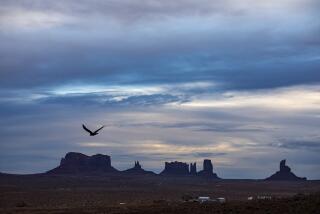Fog Collector Brings Water to Arid Chile Village : Science: The people of Chungungo had done without running water for two decades. But a new system of trapping moisture lets water flow, gardens flourish.
- Share via
CHUNGUNGO, Chile — Nets that catch fog have given the people of this village on the desert coast their first opportunity in nearly a generation to plant flowers and trees, raise pets and take showers.
Daysi Sasmaya spoke of a simple luxury: “You can bathe every day.”
Chungungo was without running water for two decades after the government closed an iron mine in the mountains above and dismantled the system that had piped water to it and the village from wells 30 miles away.
Because they could not afford to build their own system, the 200 villagers had to depend on water trucked nearly 15 miles over a dirt road so rutted and winding that there is no bus service. Once a week, a truck brought water in 50-gallon drums. Each resident was allowed a little over 3 1/2 gallons a day.
“Whenever you washed yourself or something else, you could only rinse once,” Sasmaya said. “The clothes water was used for bathing. The dishwater went into the vegetable patch.”
Thanks to a $250,000 Canadian aid project with Chungungo as its pilot site, there is plenty of water today and trees line the village’s dirt streets.
For two years, Chungungo’s 90 houses have had fresh water collected by 75 nets that capture droplets from the fog that shrouds the mountains on most days. The “fog trappers,” which resemble black plastic volleyball nets, line the brown crests where the homes of mine executives once stood.
Water runs from the nets to troughs, then into a gravity system where the water is chlorinated and descends to the village through a four-mile pipeline. The result is nearly 14 gallons a day per person at half the cost of the trucked-in water.
Pilar Cereceda, the engineer who laid out the pattern for the nets, said they are easy to maintain. The polypropylene nets should last 10 years, she said, and the other components about 20 years. Maintenance consists mainly of clearing algae from the nets and debris from the troughs.
Most of the aid money went for research that will not need to be done again, according to Cereceda. About one-fifth of it was spent on the pipeline and only 4% on the nets.
The Chilean government plans to build trappers near Paposo, another fishing village about 300 miles north of Chungungo, which now survives on less than a gallon of water a day per person.
At Paposo, “the cliffs nearby are beautiful for collectors,” Cereceda said, so costs can be reduced by setting the nets closer to the village.
Fog collection is under way in Peru, and such diverse countries as Ecuador, India, China and the Philippines have studied the Chungungo system.
Cereceda went to Kenya and Oman to help determine the best sites for collectors and feels Tanzania, Namibia and Cape Verde are other good candidates. “In Africa, the people already collect rainwater to use during the drought season; they understand how to conserve water,” she said.
Fog collection is not new. A South African scientist demonstrated it in 1903, and in the 1950s the Dole company developed a system on the Hawaiian island of Lanai that used evergreen trees.
Collection is feasible wherever there is steady fog, Cereceda said. Northern Chile has frequent fog because cold air currents from Antarctica collide with damp sea air over the desert coastline. Chungungo has up to 189 days of fog annually and 89 of patchy fog.
Gaspar Andrade, a 44-year-old Chungungo fisherman who now has roses and other flowers in his front yard, has nothing but praise for the water project.
He remembers when Bethlehem Steel ran the El Tofo mine and shipped ore from Cruz Grande, a now-unused port next to Chungungo. The village had electricity, clean water and a hospital, all provided by the company, and the people could shop at well-stocked stores in the port.
In 1970, Chile nationalized the mine and closed the hospital and stores.
“From 1970 on, we suffered from the lack of water,” Andrade said. “Thanks to Canada, we now have water. The Canadian government gave us a real present.”
More to Read
Sign up for Essential California
The most important California stories and recommendations in your inbox every morning.
You may occasionally receive promotional content from the Los Angeles Times.













